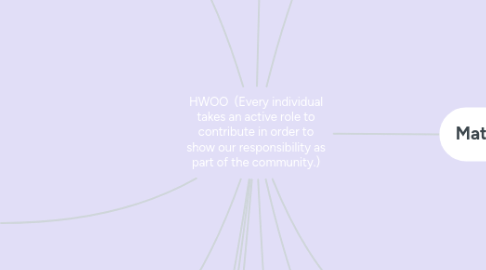
1. Social Studies: Formulate and ask questions about the past, the future, places and society, identify roles, rights and responsibilities in society
2. Bahasa Indonesia
2.1. Listening & Speaking: People listen and speak to share thoughts and feelings.
2.1.1. -Express ideas or thoughts or to respond to stories.
2.1.2. ask and respond to questions using who, what
2.2. Reading : -Illustration and print conveys meaning -People read for pleasure
2.2.1. join in with poems, rhymes, songs and repeated phrases in shared books
2.2.1.1. Vocabs: dokter, guru, petugas, koki
2.2.1.2. Gerak & Lagu; Bapak polisi
2.3. Writing: -People write to tell about their experiences, ideas and feelings.
2.3.1. -Knowledge of the alphabet and sounds: M, D, G, O, C, K -Express ideas or thoughts or to respond to stories.
2.3.1.1. Journal book: drawing and explore writing
2.4. Visual language: Visual language is all around us.
2.4.1. Introduce some familiar symbols around us,
2.4.1.1. Match building/working spaces/tools and roles
3. PE
3.1. Enjoy performing safe fundamental movement skills essential in basic athletics events. -Follow instructions to participate in activities safely (Follow the rules and being cooperative)
4. ART
4.1. Visual Art: - CU : People make meaning through the use of symbols -We can enjoy and learn from creating art Outcomes -identify the materials and processes used in the creation of an artwork create artwork in response to a range of stimuli
4.1.1. Use symbol in creating art (symbols related to roles ex: doctor +) and identify materials they used and how to make it.
4.2. Performing Art : Talk about ideas and feelings in response to dramatic performance
4.2.1. Role play to show their understanding of a certain role and the responsibility and how they support other roles
5. LOI :Different roles in a community,How different roles serve the community,Interaction of the roles within the community
6. Key concept : Function, connection and responsibility, Related concepts : role, community and interaction.
7. Mandarin
7.1. Listening and Speaking
7.1.1. Listen and respond to greetings
7.1.2. Use gestures, actions and/or body language to follow teacher’s instructions
7.2. Reading
7.2.1. Begin to read words with different tones by following the teacher
7.3. Vocabularies
7.3.1. numbers hanzi
7.3.2. teacher 老师, nanny 保姆, driver司机, students 学生, doctor 医生
8. ATL
8.1. THINKING Use discussion and play to generate new ideas and investigations
8.1.1. role-play at different places/as roles
8.2. SOCIAL Be self and socially aware.
8.2.1. Find out their place in the community (at home-child, at school - student)
8.2.2. identify roles in community
8.3. SELF-MANAGEMENT Practise strategies to overcome distractions
8.3.1. kinds of distractions
8.3.2. how to focus
8.3.3. ignore distraction
9. Math
9.1. Number
9.1.1. Count how many roles in a community
9.2. Measurement
9.2.1. identify, describe and sequence events in their daily routine for example, before, after, bedtime, story time, today, tomorrow.
9.2.2. Use the words before and after to mention the next activity
9.3. Data Handling
9.3.1. Students use chart, graph to collect information
9.3.2. Student use mind map, Venn diagram and flowchart to present their understanding of the roles
10. Profile
10.1. Balance, Thinker and knowlegeable
11. Literacy-English
11.1. Reading: Stories can tell about imagined worlds: There are established ways of setting out print and organizing books
11.1.1. Part of book (title, author, opening from left to right)
11.1.2. Fiction books
11.1.2.1. make prediction about the ending
11.1.2.2. characters in the story
11.1.2.3. moral of the story
11.2. Writing: Talking about our stories and pictures helps other people to understand and enjoy them
11.2.1. journal writing, labeling, draw and tell
11.2.1.1. Uses illustrations to tell stories
11.2.2. Make personal connections to visual texts
11.3. Oral: People listen and speak to share thoughts and feelings
11.3.1. Show and tell
11.3.2. presenting their work
11.3.2.1. planning and carrying out activities
11.3.3. Show curiosity and ask questions about pictures or text
11.3.3.1. question to teach: What , who, Where
11.4. Visual language: We can enjoy and learn from visual language
11.4.1. observe visual cues that indicate context; show understanding by matching pictures with context
11.5. Letter and sounds: Knows most letter names and some letter sounds
11.5.1. G,O,C,K,E,U,R,H
11.6. Song, rhymes, Vocabularies
11.6.1. roles, job, community helper (Doctor, teacher, firefighter, dentist, chef, policeman, etc)
11.6.2. pat-a-cake , Teacher, teacher what do you do?
